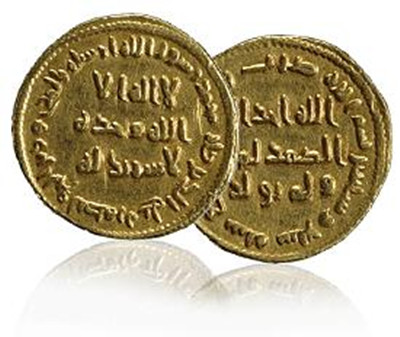On the front, where a Byzantine coin would have had the emperor, it has a full-length figure of the Caliph, Abd al-Malik. And on the back, where the Byzantines would have put a cross, there is a column with a sphere at the top.
在第一枚金币的正面,通常的拜占庭货币放置帝王像的地方,是哈里发阿卜杜勒马利克的全身像。这是已知最早的穆斯林画像。金币背面,拜占庭人铸十字架的地方,铸着一个顶着圆球的圆柱。
Al-Malik is shown full-figure, standing and bearded, wearing Arab robes and a Bedouin scarf headdress, with his hand resting on a sword at his waist. It's a fascinating image. It's a unique source for our knowledge of the dress and the regalia of the early caliphs, and it's probably the oldest known depiction of a Muslim. His pose is menacing, he looks as though he's about to draw his sword, and the lines below his waist are almost certainly meant to represent a whip. What we have is an image to inspire fear and respect, an image that makes it clear that the eastern Mediterranean now has a new faith, and a formidable new ruler. A letter from one of his governors echoes the image's implicit message:
阿卜杜勒马利克的全身像为站姿,他长须,着阿拉伯袍,戴贝都因式头巾,腰悬宝剑,一手搭在剑上。这幅像十分精彩,是我们了解早 期哈里发服饰与王权象征的唯一途径。他威风凜凜,仿佛就要拔剑在手。 腰下的线条应代表着长鞭。像的目的是要让人产生敬畏,表明地中海东部如今已有了新的信仰以及威严的新统治者。他手下某位官员的信函也应和了图像暗含的信息:
"It is Abd al-Malik, the commander of believers, a man with no weaknesses, from whom rebels can expect no indulgence! On the one who defies him falls his whip!"
阿卜杜勒马利克,信徒之统帅,无懈可击的领袖,对叛徒绝不手软!他的鞭子会抽到与他对抗的人身上!
He cuts an impressive awe-inspiring figure-although a less reverential source tells us that he had such appalling halitosis, that he was nicknamed the "fly-killer". But, bad breath or not, Abd al-Malik was the most important Muslim leader since Muhammad himself, because he transformed what might have been merely a string of ephemeral conquests into an abiding state, a state that would survive in one form or another until the end of the First World War.
他的模样十分庄严,但据野史记载,他有极为严重的口臭,以致有“苍蝇杀手”的绰号。但无论如何,他都是自穆罕默德之后最伟大的穆斯林领袖,是他将这一片原本可能只是短期征服的领土变成了统一的国度,以不同的形态一直延续至一战结束。
Abd al-Malik was a new breed of Islamic leader. He had no personal memory of Muhammad, and he shrewdly saw how best to exploit the administrative traditions of earlier empires-especially Rome and Byzantium-in order to establish his own, as Professor Hugh Kennedy, of the School of Oriental and African Studies, explains.
阿卜杜勒马利克不同于以往的伊斯兰领袖。他没有亲身接触过穆罕默德。而且他狡猾地从早期帝国,尤其是罗马和拜占庭帝国的统治经 验中吸取了最好的传统来建立自己的国家。伦敦亚非学院的休肯尼迪教授解释道。



